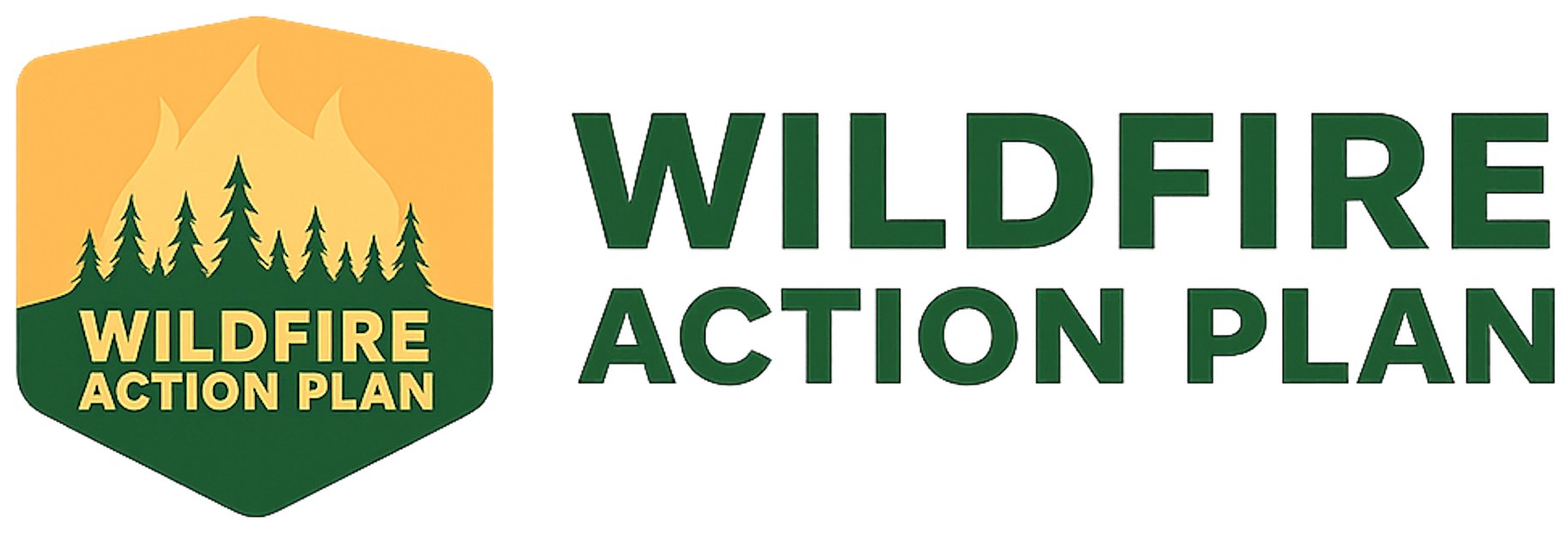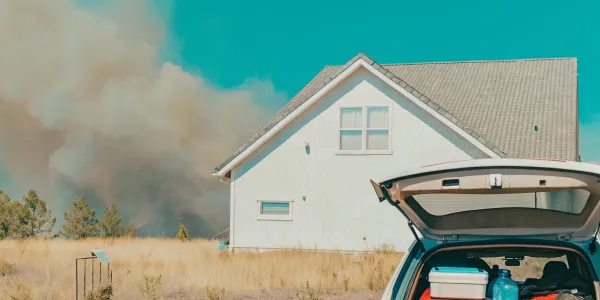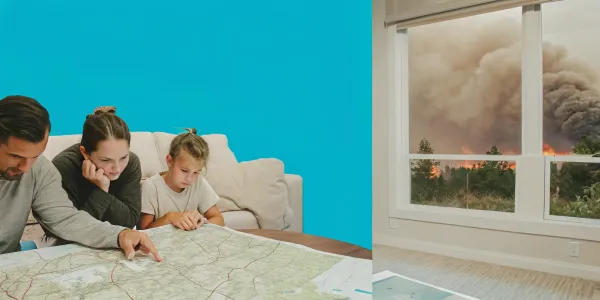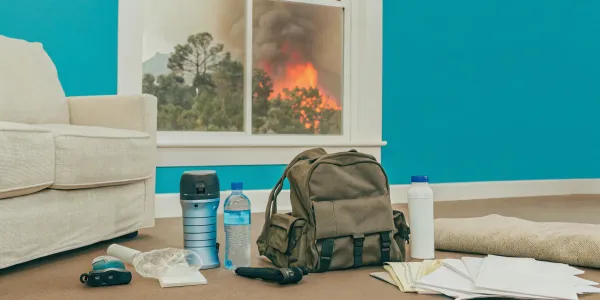How to Conduct a Wildfire Risk Assessment for Your Home
Learn how to conduct a home wildfire risk assessment, spot vulnerabilities, and take practical steps to protect your property and improve your insurance options.
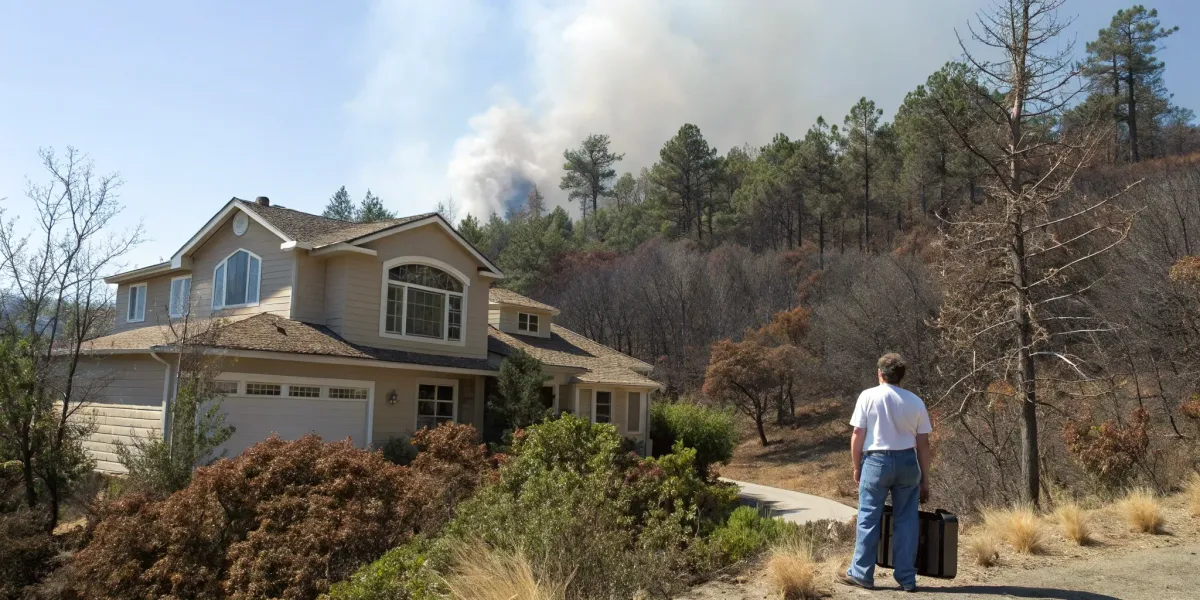
It’s a common belief that if a wildfire is heading your way, there’s little you can do besides evacuate and hope for the best. This myth leaves homeowners feeling powerless. The reality is that your home’s survival often comes down to its own defenses, particularly against wind-blown embers. A home that is properly prepared can withstand a wildfire even when others nearby do not. Your power lies in preparation, and that begins with a clear-eyed look at your property’s weaknesses. This guide will show you how to conduct a home wildfire risk assessment to uncover those hidden dangers, from flammable mulch near the foundation to uncovered attic vents, giving you a clear path to fortify your home.
Key Takeaways
- Pinpoint Your Home's Specific Weak Spots: A true wildfire risk assessment goes beyond general maps. You must conduct a detailed inspection of your home's construction, landscaping, and surrounding terrain to understand its unique vulnerabilities and create an effective protection plan.
- Defend Against Embers, Not Just Flames: Most homes are lost to small, wind-blown embers that find fuel in gutters or enter through vents. Your highest priority should be creating a non-combustible 5-foot zone around your foundation and hardening these small entry points.
- Document Your Actions for Your Insurer: Every mitigation step you take is a point in your favor. Keep a detailed record with photos and receipts of all improvements to prove you are actively reducing your risk, which is your strongest tool for maintaining insurance coverage.
What is a Wildfire Risk Assessment?
A wildfire risk assessment is a detailed look at how vulnerable your specific property is to a wildfire. Think of it as a home health check-up, but for fire danger. It goes beyond general maps of high-risk zones to evaluate the unique factors of your home and its immediate surroundings. This includes everything from your roofing material and the plants in your garden to the slope of your land. The goal is to identify weak spots so you can take targeted, effective action to protect your home and family.
What a Real Assessment Includes
While online tools can give you a general idea of your area's risk, a true assessment is much more personal. As experts at Wildfire Risk to Communities note, the only way to really understand your home's susceptibility is through an individual evaluation. This means looking closely at your property’s specific characteristics. A thorough assessment requires you to actively manage your home’s defenses and know exactly what to do in an emergency. Creating a personalized Wildfire Action Plan is the most effective way to document your risks and build a clear strategy for addressing them, from home hardening projects to evacuation routes.
Common Myths About Wildfire Risk
It’s easy to feel powerless when you hear about the unpredictability of wildfires, but one of the biggest myths is that there’s nothing you can do to mitigate the risk. This simply isn’t true. While we can't control where a wildfire starts, you have significant control over your home's ability to survive one. Another common myth is that wildfires are a purely natural force that should be left to burn freely. The reality is that modern wildfires are often more intense due to climate change and human factors, making proactive home protection essential for communities built near wildlands.
How Your Assessment Impacts Your Insurance
Your home’s wildfire risk assessment has a direct impact on your insurance coverage and costs. Insurers use these evaluations to decide whether to offer a policy and how to price it. If your home is deemed high-risk, you could face non-renewal, higher premiums, or policies with limited coverage that exclude certain types of damage. With wildfire risk growing across the country, these insurance challenges are becoming more common. By conducting your own assessment and taking steps to lower your risk, you’re not just protecting your property—you’re also making a case to insurers that your home is a safer, more insurable bet.
Pinpoint Your Property's Vulnerabilities
Before you can build an effective defense, you need to know where you’re most exposed. A wildfire doesn’t see a “house”; it sees fuel. Your home and the land around it are a collection of potential ignition points. Understanding these weak spots is the first step toward creating a meaningful protection plan that insurers will recognize. A thorough assessment looks at your home’s construction, your landscaping, and the surrounding terrain. With a clear view of your specific risks, you can focus your efforts where they’ll have the greatest impact and build a home that’s more resilient to wildfire.
Your Home's Building Materials and Construction
The materials your home is made of are a critical factor in its ability to survive a wildfire. Some materials can ignite easily, while others can resist flames and heat. For example, natural building materials like wood siding or shingles offer poor fire resistance compared to dense concrete, stucco, or plaster. Your roof is the most vulnerable surface, so materials like asphalt shingles, slate, or metal are far safer than wood shakes. The same logic applies to your windows; dual-paned tempered glass is more resistant to breaking from heat than single-paned glass, which can shatter and allow embers inside. Take a close look at what your home is built with, as these are the core components of its defense.
The Landscaping and Vegetation Around Your Home
What’s growing around your house is just as important as the house itself. Your yard can either act as a protective buffer or as a fuse leading fire directly to your door. The most common risks are flammable mulch, overgrown plants, stacks of firewood, and wooden lawn furniture. These items have been a primary reason homes burn in wildfires. To create a safer space, you must manage the vegetation near your home. Don’t let plants touch your house, windows, or decks. A core principle of fire-smart landscaping is to keep the area within five feet of your foundation clear of anything that can easily burn.
Your Property's Slope and Surroundings
Wildfire behavior is heavily influenced by topography. Fire spreads much faster uphill, so a home built on a steep slope is at a significantly higher risk than one on flat ground. The surrounding environment also plays a major role. A house nestled in a dense forest faces different challenges than one in a grassy field or a tightly packed suburban neighborhood. While tools like Wildfire Risk to Communities provide a valuable big-picture view, they can’t replace a close look at your immediate surroundings. The only way to truly assess your home’s susceptibility is through an individual assessment that accounts for your specific location and the landscape features that could channel fire toward you.
Why Embers Are the Biggest Threat
Many people imagine a wildfire as a giant wall of flames, but the most common cause of home ignition is far smaller and more subtle. The biggest threat is often embers—small, glowing pieces of burning wood and vegetation that can be carried by the wind for a mile or more ahead of the fire. Many homes burn because these small embers land on or near them, often after the main fire has passed. They can get lodged in flammable materials like a pile of dry leaves in a gutter, a wicker doormat, or be sucked into attic vents. Understanding that embers are the primary threat shifts your focus from fighting a fire front to hardening your home against these tiny, persistent threats.
How to Conduct Your Own Assessment
Inspect Your Home's Exterior, Step-by-Step
The first step is to understand your property’s specific situation. Start by walking the perimeter of your home and yard with a critical eye. What do you see? Look for anything that could easily burn, like piles of dry leaves, dead vegetation, or stacks of firewood next to the house. Take note of the condition of your landscaping within 30 feet of your home—is it overgrown or well-maintained?
This initial walkthrough isn’t about fixing everything at once; it’s about creating a baseline. You’re simply gathering information on potential hazards. Understanding your local environment and how it interacts with your home is the foundation for an effective wildfire preparedness plan.
Find Your Home's Structural Weak Points
After assessing your yard, turn your attention to the house itself. Wildfires often ignite homes not by a wall of flame, but by wind-blown embers that find a weak spot. A thorough home assessment means looking closely at your home’s materials and design. Are your roof shingles Class A fire-rated, or are they made of a flammable material like wood? Are the vents leading into your attic or crawlspace covered with a fine metal mesh to block embers?
Check your windows—are they single-pane, which can easily break from heat, or multi-pane? Look at your siding, decks, and fences. The goal is to identify any part of your home’s structure that could trap or be ignited by embers, giving you a clear list of vulnerabilities to address.
When to Call in a Professional
Feeling overwhelmed? That’s completely normal. If you’re short on time or don’t feel confident in your ability to spot every vulnerability, hiring a professional risk assessor is a smart move. These experts are trained to conduct a thorough evaluation of your property and provide a detailed report with specific, prioritized actions to mitigate your risk.
A professional assessment can be especially valuable when dealing with insurance companies, as it provides a credible, third-party evaluation of your home’s risk and the mitigation steps you’ve taken. Think of it as an investment in clarity and peace of mind. A certified wildfire mitigation specialist can help you focus your efforts where they’ll matter most.
Tools and Checklists to Guide You
You don’t have to do this from memory. Several online tools can give you a high-level view of your area’s wildfire risk. Websites like the Wildfire Risk to Communities portal use data to map risk across the country, allowing you to see the bigger picture just by typing in your address.
Once you understand your general risk, a detailed checklist is your best friend for the hands-on inspection. It ensures you don’t miss critical areas like gutters, eaves, and the space under your deck. To get started, you can create your own personalized and comprehensive Wildfire Action Plan to guide you through every step, from assessment to action, ensuring your home is as prepared as possible.
Create Your Defensible Space
Creating defensible space is one of the most effective actions you can take to protect your home from wildfire. Think of it as a buffer zone you create between your house and the surrounding grass, trees, and wildland. This space is designed to slow or stop the spread of wildfire and protect your home from catching fire—either from direct flame contact or from flying embers. It’s a critical concept that fire departments and insurance companies focus on, and it’s divided into three distinct zones, each with its own set of rules. Managing these zones properly not only increases your home’s chances of survival but also demonstrates to insurers that you are actively reducing your risk.
Zone 1: The Critical Ember-Resistant Zone (0-5 feet)
This is the area immediately surrounding your home, and it’s the most important. The goal here is to create a space where embers cannot find fuel to ignite. According to CAL FIRE, it is crucial to keep the area right next to your house clear of anything that can burn easily. This means using non-combustible materials like gravel, pavers, or concrete against the foundation instead of bark or rubber mulch. Remove all dead leaves, pine needles, and other debris from under your deck and in corners where they might collect. Move firewood piles and flammable patio furniture out of this zone. This five-foot buffer is your home’s last line of defense against ignition from embers, which are the leading cause of home loss during a wildfire.
Zone 2: The Lean, Clean, and Green Zone (5-30 feet)
In this zone, the focus is on interrupting a fire’s path and preventing flames from reaching your home. Landscaping should be lean, clean, and green. This means keeping plants properly irrigated and free of dead material. You should keep plants that have a lot of sap or resin, which burn easily, far away from your house. Create separation between trees, shrubs, and other vegetation. Prune tree branches so the lowest limbs are 6 to 10 feet from the ground. Regularly trim plants and clean up fallen leaves and branches, especially near your house. This maintenance reduces the fuel available to a fire and keeps a ground fire from climbing up into the tree canopies.
Zone 3: The Reduced Fuel Zone (30-100+ feet)
This outer zone serves to slow a wildfire and reduce its intensity before it gets close to your house. The goal is to reduce the overall density of vegetation. You can create a fire break by clearing a space around your property to stop fire from spreading. This involves removing dead plants, dry grass, and other debris. Thin out trees and shrubs to create horizontal and vertical space between them, which helps prevent fire from spreading from treetop to treetop. If your property is on a slope, you may need to extend this zone even further, as fire spreads more quickly uphill. This is your first opportunity to stop an approaching fire in its tracks.
How to Maintain Your Zones Year-Round
Defensible space isn't a one-time project; it requires ongoing attention. Your goal is to keep your landscape healthy and clean throughout the year, especially during peak fire season. Water and fertilize your plants properly to keep them healthy and less flammable. Regularly trim your plants and clean up fallen leaves and branches, especially near your house. A well-maintained property is a key part of a resilient home. By making this a regular habit, you not only protect your family and property but also build a powerful case for your insurability. A personalized Wildfire Action Plan can help you create a simple maintenance schedule to stay on track.
Key Areas to Fortify and Monitor
Once you’ve identified your property’s general vulnerabilities, it’s time to focus on the specific parts of your home that are most susceptible to wildfire. Many homes are lost not to the main wall of fire, but to the storm of embers that precedes and follows it. These small, glowing embers can travel a mile or more and find their way into the smallest cracks and crevices. Fortifying these key areas is one of the most effective ways to protect your home and is a critical part of any Wildfire Action Plan.
Your Roof, Eaves, and Gutters
Your roof is your home's first line of defense, and its largest, most exposed surface. Embers can easily land and accumulate here. The best protection is a Class A fire-rated roof made of materials like asphalt shingles, metal, or tile. Just as important are your gutters, which can become troughs of tinder when filled with dry leaves and pine needles. You must keep your gutters clean, especially during fire season. Installing metal gutter guards can help prevent this dangerous buildup. Finally, inspect your eaves; open eaves can trap hot embers against your home’s framing, so consider having them boxed in for better protection.
Windows, Doors, and Vents
Embers act like tiny intruders, seeking any opening to get inside your home. Vents—for your attic, foundation, or under eaves—are a primary entry point. Cover all vent openings with 1/8-inch metal mesh screening to block embers while still allowing for airflow. Windows are another weak point; intense radiant heat can shatter single-paned glass, giving fire an easy way in. Upgrading to dual-paned windows with tempered glass offers significantly more resistance. Ensure all your doors, including the garage door, form a tight seal to keep embers out. Applying new weather stripping is a simple, effective fix for any gaps.
Decks, Fences, and Other Attachments
Structures attached to your home can act as fuses, carrying fire directly to your walls. A wooden deck or fence that ignites can easily spread flames to the main house. If you have a deck, keep the area underneath it completely clear of flammable debris and stored items. For fences that connect to your house, a simple but powerful modification is to replace the five feet of fencing closest to the house with a noncombustible metal gate. This creates a crucial firebreak. The goal is to prevent a small fire on an attachment from becoming a catastrophe for your home.
Manage Your Trees and Shrubs
The vegetation closest to your home requires careful management. This isn’t about clear-cutting your property, but about creating smart separation. Start by removing any dead or dying trees and shrubs. Prune any tree branches that hang over your roof or deck, and ensure no part of a tree is within five feet of your house. Following fire-smart landscaping principles is essential for maintaining your defensible space. Regularly trimming lower tree branches (a practice called "limbing up") also helps prevent a ground fire from climbing into the tree canopy and spreading more aggressively.
Put Your Protection Plan into Action
Okay, you’ve walked your property and identified the weak spots. Now what? An assessment is only as good as the action it inspires. This is where you turn your knowledge into a concrete plan to protect your home, your family, and your financial future. It can feel overwhelming, but you don’t have to do everything at once. The key is to start with the most critical tasks and build resilience over time. This process of "home hardening" is exactly what insurers are looking for when they decide who to cover in high-risk areas. Let's break down how to methodically tackle your upgrades, finalize your safety plans, and create a maintenance routine that makes preparedness a simple part of your life.
Prioritize Your Safety Upgrades
Your assessment likely revealed a list of potential projects, from small fixes to major renovations. The first step is to prioritize. Start with the changes that offer the most protection for the least cost and effort. This often means focusing on the 0-5 foot ember-resistant zone right around your house. Clearing away flammable mulch, moving woodpiles, and cleaning gutters are high-impact first steps. From there, you can plan for larger projects like replacing vents or upgrading windows. With wildfire risk growing, making smart choices during any renovation is crucial. Creating a tiered plan based on your budget and your home’s specific vulnerabilities helps you make steady, meaningful progress toward a safer, more insurable property.
Choose Fire-Resistant Building Materials
If you’re building or remodeling, you have a huge opportunity to fortify your home from the ground up. Choosing the right materials is one of the most effective long-term strategies for wildfire defense. Focus on non-combustible materials like fiber-cement siding, metal roofing, stucco, and brick. For decks and fences, consider composite materials or hardwoods with a Class A fire rating. Even small details matter—tempered glass windows are more resistant to breaking from heat than standard glass. These choices create a hardened shell that can resist ignition from embers, which are the primary cause of home loss during a wildfire.
Finalize Your Evacuation Plan
Knowing your home’s vulnerabilities helps you understand when it’s time to leave. Your assessment gives you the context to create a truly effective evacuation plan. Don’t wait for an emergency to figure it out. Your plan should include at least two escape routes from your neighborhood, a designated meeting spot for your family, and a communication plan in case cell service is down. Pack a "go bag" for each family member and your pets with essentials like water, medications, and important documents. The most important step? Practice. A practiced plan removes panic from the equation, allowing you to act quickly and confidently when every second counts.
Set a Regular Maintenance Schedule
Home hardening isn't a one-and-done project; it's an ongoing commitment to safety. The best way to stay on top of it is to create a simple maintenance schedule. Just like you change the batteries in your smoke detectors, you should schedule regular checks for your wildfire defenses. Use a calendar to remind yourself to clean your roof and gutters before fire season, inspect vents for damage, and maintain your defensible space zones. Regular maintenance ensures that the investments you’ve made in protecting your home continue to work effectively year after year. A tool like the Wildfire Action Plan can help you track these tasks and keep your home prepared.
From Assessment to Action: Your Next Steps
Understanding your home's specific risks is the first step, but turning that knowledge into a concrete plan is what truly protects your family and property. The assessment gives you a roadmap; now it’s time to start the work. This process isn’t about a single weekend of yard work. It’s about building a new, more resilient way of living with wildfire risk. The following steps will help you prioritize your efforts, connect with valuable resources, and take control of your home’s defense. By methodically addressing your vulnerabilities, you can significantly lower your risk and demonstrate to insurers that you are a proactive, responsible homeowner.
Reduce Your Risk Right Now
You don’t have to do everything at once. Start with immediate, high-impact actions. Begin by clearing dead leaves, pine needles, and other flammable debris from your roof, gutters, and the area within five feet of your foundation. This simple act can stop embers from finding a place to ignite. Next, move flammable items like woodpiles, patio furniture with combustible cushions, and propane tanks at least 30 feet away from your home. You can get a clearer picture of your property’s specific vulnerabilities by following established frameworks like the Firewise USA® program, which provides a clear, structured path for making your home and yard more resistant to wildfires.
Plan for Long-Term Resilience
Wildfire risk is an ongoing reality, not a one-time threat. Your goal should be to create a sustainable plan for long-term resilience. While broad risk maps are helpful, the most effective protection comes from an individual assessment of your home’s unique structure and landscape. This is where you move from a simple checklist to a living strategy. Your long-term plan should include a schedule for regular maintenance, a budget for future home hardening projects like installing fire-resistant vents or windows, and a clear evacuation strategy. A comprehensive Wildfire Action Plan helps you organize these efforts, ensuring your home is prepared not just for this fire season, but for every season to come.
Connect with Local Fire Safety Resources
You are not in this alone. Your local fire department and state forestry agency are your most valuable allies. Many of these organizations offer free resources, property consultations, or safety checks to help you identify and mitigate risks. They can provide guidance that is specific to your local climate, topography, and vegetation. Reaching out to them can also connect you with neighborhood programs and grants for home hardening projects. Learning how to prevent wildfires is a community-wide responsibility, and your local experts are there to support your efforts. Don’t hesitate to ask for their professional advice.
Share Your Progress with Your Insurer
In today’s challenging insurance market, demonstrating your proactive efforts is critical. Document every single mitigation step you take. Keep a detailed log with photos, receipts for materials or labor, and dates of completion. When your policy is up for renewal, or if you are seeking new coverage after a non-renewal, share this documentation with your insurance agent. This record proves you are actively reducing your property's risk, making you a more attractive client. It transforms the conversation from one about unavoidable risk to one about your commitment to safety. A well-documented preparedness plan can be your most powerful tool in maintaining affordable and adequate homeowners insurance.
Related Articles
- Create Your Wildfire Action Plan
- Wildfire Preparedness Resources
- Wildfire Action Plan Home
- Wildfire Action Plan FAQ
- About Wildfire Action Plan
Frequently Asked Questions
This all feels overwhelming. Where do I even start? I completely understand. The key is to start small and focus on what matters most. Begin with the area within five feet of your home's foundation. Walk around your house and clear out any dead leaves, pine needles, or flammable mulch. Move your woodpile or patio furniture with fabric cushions further away. These simple, often free, actions create a critical buffer against embers and give you an immediate, powerful win.
Will doing all this work guarantee I can keep my insurance? While there are no absolute guarantees in the current insurance market, taking these steps is the single best thing you can do to take control. By hardening your home and creating defensible space, you are actively lowering your property's risk profile. Be sure to document every improvement with photos and receipts. This provides concrete proof to your insurer that you are a responsible homeowner, making your property a much more attractive and defensible risk for them to cover.
What's the most important thing I can do if I have a limited budget? You don't need a huge budget to make a huge difference. The most effective actions are often about maintenance, not expensive renovations. Focus on keeping your property clean. Regularly clearing your roof and gutters of debris, trimming back overgrown vegetation, and keeping the area under your deck free of flammable materials are incredibly effective tasks that cost little to no money. Diligent upkeep is your most powerful and affordable tool.
My home isn't new. Is it too late to make it safer? Not at all. Any home, regardless of its age, can be made significantly safer. You don't have to rebuild your house to protect it. You can retrofit many of its most vulnerable points over time. Start by adding 1/8-inch metal mesh over your vents, replacing the last five feet of a wooden fence with a metal gate, or applying new weather stripping to your garage door. Every single improvement, big or small, adds another layer of protection.
Is this a one-time fix, or do I have to do this all the time? Think of wildfire preparedness like any other home maintenance. It’s an ongoing commitment, not a one-time project. Your defensible space, in particular, needs regular attention as plants grow and seasons change. The best approach is to create a simple annual schedule. For example, plan to clear your roof and gutters in the spring before fire season starts and do another check-up in the fall. Making it a regular habit keeps your home protected and makes the work feel much more manageable.
